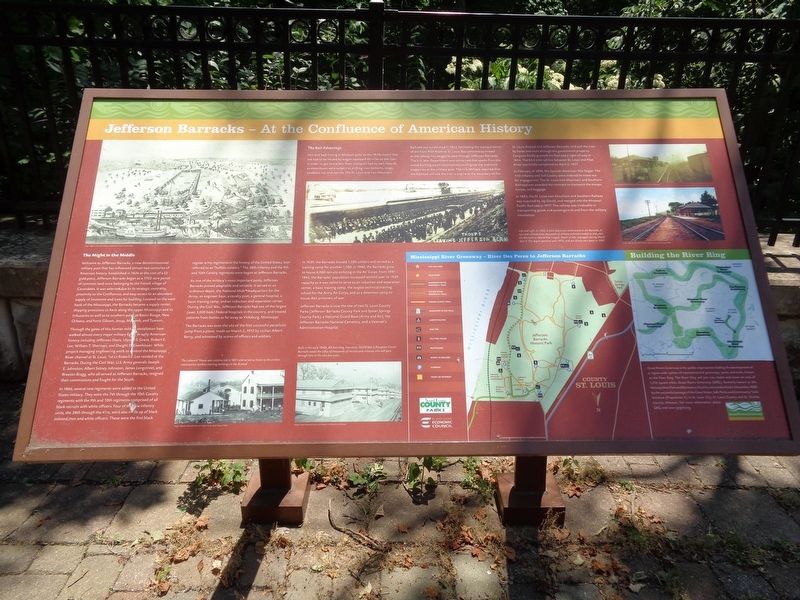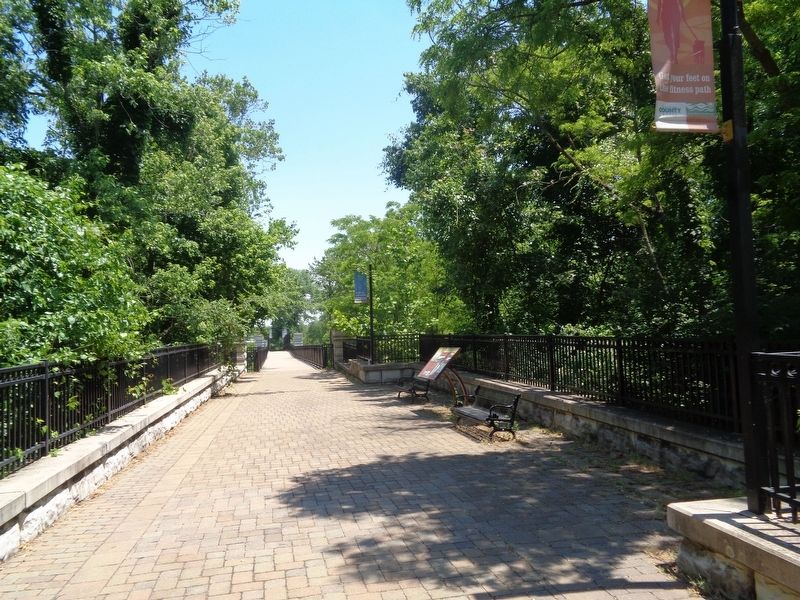Lemay in St. Louis County, Missouri — The American Midwest (Upper Plains)
Jefferson Barracks - At the Confluence of American History
Inscription.
The Might in the Middle
Welcome to Jefferson Barracks, a now decommissioned military post that has influenced almost two centuries of American history. Established in 1826 at the cost of a $5 gold piece, Jefferson Barracks began as a 1702-acre parcel of common land once belonging to the French village of Carondelet. It was selected due to its strategic centrality, proximity to the Confluence, and easy access to an abundant supply of limestone and trees for building. Located on the west bank of the Mississippi, the Barracks became a supply center, shipping provisions to forts along the upper Mississippi and its tributaries as well as to southern posts at Baton Rouge, New Orleans, and Forts Gibson, Jesup, Macomb and Towson.
Through the gates of this former military installation have walked almost every major military figure in early American history including Jefferson Davis, Ulysses S. Grant, Robert E. Lee, William T. Sherman, and Dwight D. Eisenhower. While project managing engineering work to control the Mississippi River channel at St. Louis, 1st Lt Robert E. Lee resided at the Barracks. During the Civil War, U.S. Army generals Joseph E. Johnston, Albert Sidney Johnston, James Longstreet, and Braxton Bragg, who all served at Jefferson Barracks, resigned their commissions and fought for the South.
In 1866, several new regiments were added to the United States military. They were the 7th through the 10th Cavalry regiments with the 9th and 10th regiments comprised of all black recruits with white officers. Four of the new infantry units, the 38th through the 41st, were also made up of black enlisted men and white officers. These were the first black regular army regiments in the history of the United States, later referred to as "buffalo soldiers." The 38th Infantry and the 9th and 10th Cavalry regiments were begun at Jefferson Barracks.
As one of the military's most important posts, Jefferson Barracks proved adaptable and versatile. It served as an ordnance depot, the National Mule Headquarters for the Army, an engineer base, a cavalry post, a general hospital, a basic training camp, and an induction and separation center. During the Civil War, Jefferson Barracks had one of the largest (over 3,000 beds) Federal hospitals in the country, and treated patients from battles as far away as Vicksburg, Mississippi.
The Barracks was even the site of the first successful parachute jump from a plane, made on March 2, 1912 by civilian Albert Berry, and witnessed by scores of officers and soldiers.
In 1939, the Barracks housed 1,500 soldiers and served as a training camp for another 1,500. In 1940, the Barracks grew to house 6,000 recruits enlisting in
the Air Corps. From 1941-1945, the Barracks' population increased tenfold over its 1939 capacity as it was called to serve as an induction and separation center, a basic training camp, the largest technical training school for the Army Air Corps, and as a detention camp to house Axis prisoners of war.
Jefferson Barracks is now the site of two St. Louis County Parks (Jefferson Barracks County Park and Sylvan Springs County Park), a National Guard Base (Army and Air), the Jefferson Barracks National Cemetery, and a Veteran's Administration Hospital.
The Rail Advantage
Iron and lead mining in Missouri prior to the 1850s meant that ore had to be hauled by wagon eastward 40 miles to the river in order to get to market. River transport had its own hazards, as steamboats were subject to shifting river bottoms, snags, sandbars, ice, and storms. The St. Louis and Iron Mountain Railroad was established in 1852, facilitating the transportation of ore from Pilot Knob to St. Louis. But controversy ensued as the railway line sought to pass through Jefferson Barracks. The U.S. War Department was concerned that sparks from the wood-burning steam locomotives could ignite the ordnance magazines at the military post. The U.S. Military required that the Railroad unhook the train's engine at the boundary of the St. Louis Arsenal and Jefferson Barracks, and pull the train by horse and mule through the government property. Congress finally granted the Railroad a right-of-way in 1854. The 84.5 mile rail line between St. Louis and Pilot Knob was finally completed on April 2, 1857.
In February of 1898, the Spanish-American War began. The 11th Infantry and 3rd Cavalry were ordered to move out for engagement. The St. Louis Iron Mountain and Southern Railroad was awarded the contract to transport the troops, horses, and baggage.
In 1883, the St. Louis Iron Mountain and Southern Railway was acquired by Jay Gould, and merged into the Missouri Pacific Railroad in 1917. The railway was invaluable in transporting goods and passengers to and from the military installation.
Erected by Great Rivers Greenway, Saint Louis County Parks and St. Louis County Economic Council.
Topics and series. This historical marker is listed in these topic lists: African Americans • Parks & Recreational Areas • Railroads & Streetcars • War, World II. In addition, it is included in the Former U.S. Presidents: #34 Dwight D. Eisenhower series list.
Location. 38° 31.207′ N, 90° 16.279′ W. Marker is in Lemay, Missouri, in St. Louis County. Marker is on Mississippi River Greenway, on the right when traveling east. The marker is located off a bike path (the Mississippi River Greenway) that goes from Jefferson Barracks Park to River City Casino. Touch for map. Marker is at or near this postal address: 9880 Mississippi River Greenway, Saint Louis MO 63125, United States of America. Touch for directions.
Other nearby markers. At least 8 other markers are within walking distance of this marker. Jefferson Barracks Historic Site - World War II Reception Center #1772 (within shouting distance of this marker); Jefferson Barracks Historic Site - Old Ordnance Room (about 400 feet away, measured in a direct line); Jefferson Barracks Historic Site - Tent City (about 600 feet away); A Longstanding, Strategically Central Military Post (about 600 feet away); Jefferson Barracks - A River Flowing Through Time (approx. 0.2 miles away); The Lewis and Clark Expedition Across Missouri (approx. 0.2 miles away); Operation Desert Shield & Desert Storm (approx. 0.2 miles away); Missouri Military Memorial (approx. 0.2 miles away). Touch for a list and map of all markers in Lemay.
Credits. This page was last revised on June 20, 2020. It was originally submitted on June 19, 2020, by Jason Voigt of Glen Carbon, Illinois. This page has been viewed 336 times since then and 36 times this year. Photos: 1, 2. submitted on June 20, 2020, by Jason Voigt of Glen Carbon, Illinois. • J. Makali Bruton was the editor who published this page.

